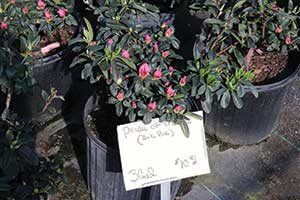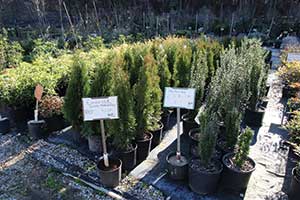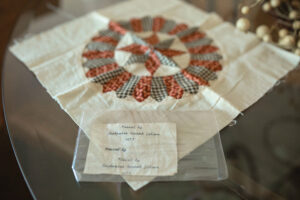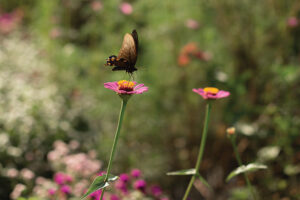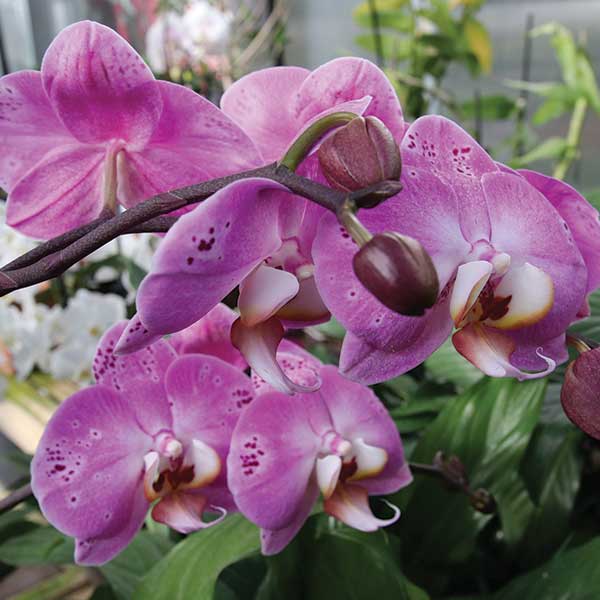
Story by Leigh Pritchett
Photos by Graham Hadley
In 2020, thoughts and energy turned to the outdoors in a big way.
Nature provided an outlet for exercise, enjoyment and escape.
Landscaping not only was an avenue for creativity, but also an opportunity to revive underutilized sections of the yard. Some projects even turned outdoor areas into comfortable, functional living spaces.
All this activity and renewed interest made 2020 a busy year for plant nurseries, garden centers and landscape artists.
“People who never gardened before wanted to do it,” said Michelle Warren, horticulturist with Warren Family Garden Center and Nursery in Moody. “… We definitely had a huge number of new people from all over Alabama to come see us. … There was a huge uptick in sales from spring right up to fall. … I think any garden center could say that.”
Geneva Jones of Crawford Nursery in Odenville agreed. Because people were home more, they devoted time to sprucing up their yard. She expects that to continue in 2021.
“It’s going to be interesting to see what happens this year,” said Will Crawford, owner of Crawford Nursery.
Another trend that came as a bit of a surprise was the surge in vegetable and herb gardening.
“That was a big trend last spring and through the summer,” said Warren. “… That was a big trend we didn’t expect.”
Warren believes fruit trees and blueberries are likely to see lots of interest this year.
Making a plan
Gardens have a specific purpose, whether it is to beautify, to attract birds or butterflies, or to reclaim some dead space.
Every successful landscaping project begins with a plan, say the experts.
They suggest photographing the area to be landscaped to give nursery or garden center employees an idea of the layout. Some nurseries and garden centers may even draw a landscaping plan for customers. These plans incorporate the customers’ wishes, while giving attention to essential details, such as the amount of sun or shade, available space, and growth potential of each plant.
John Hazelwood, owner of Hazelwood’s Greenhouses and Nursery in Pell City, said a landscaping plan also should take into account other plants and trees in the yard and the impact they will have on the new plants. He gave as an example water oaks and willow oaks, both of which are “heavy feeders.” Their presence can deplete the soil of water, fertilizer and nutrients that other plants need.
Once the landscaping plan is drawn, the designer or employees at the nursery or garden center should be consulted if plant substitutions are necessary, said Hazelwood and daughter Shelly Martin of Pell City, owner and manager of Landscapes by Shelly. If the wrong plant is substituted, it may outgrow its allotted space and disrupt the whole design.
Hazelwood said homeowners can install landscapes themselves. They just need to be able to read landscape plans to know which plant goes where. Labeling is extremely important. The plants should be labeled before and after placement so that the homeowner knows what each one is.
Going for less
In the early 2000s, landscaping concepts centered on layering and mass planting, Martin said. In the past five or six years, the theme has been on the minimal and the contemporary, concentrating on the use of specific plants for a certain effect or focal point.
Two words – “low maintenance” – describe the kind of landscapes individuals have been wanting lately.
“Low maintenance is a big thing,” Jones said.
Hazelwood added, “They would really like no maintenance, but there’s no such thing.”
Even if the landscape is considered low maintenance, Martin said periodic attention is still necessary. “The landscape will look only as good as the maintenance.”
Modern landscapes, Jones explained, are “open designs, where everything is not so crowded. They use a lot of boxwoods and (ornamental) grasses and things like that.”
As for boxwoods, Jones noted that those landscape staples from the past – in addition to needlepoint hollies and dwarf yaupon – are receiving renewed interest.
Hazelwood said japonica and sasanqua camellia also “are hot right now.”
Homeowners are particularly interested in dwarf variations of plants because they think these will always remain small and need little to no pruning. Nonetheless, Martin said dwarf plants can grow to be sizable; they just may take longer to do it.
Martin noted that landscaping does not last forever. It will need to be redone periodically.
“Your landscape is basically like painting your house,” she said. The landscape should be revamped every eight to 10 years, and plants that require heavy pruning should be replaced after 12 to 15 years.
Seeking variety
In addition to low maintenance, other highly requested landscape features are colors and textures.
Martin said color and fragrance lend an air of welcome to a home.
Warren and Martin said golds, purples, greens, blues and chartreuse (such as Limelight hydrangea and Little Lime hydrangea) have been the colors of choice.
Ornamental grasses – pink muhly grass, adagio grass, dwarf fountain grass, carex, Sassy Grass, etc. – give texture to a landscape, said Jones.
A good landscaping design offers beauty for all seasons, Martin said.
By using a variety of plants, “you can design a landscape that has color, something happening year-round,” said Jones.
For example, a landscape including common azaleas (bloom once in spring), gardenias, Encore azaleas (bloom spring, summer and fall), hydrangeas (bloom in summer), camellia japonica (bloom in February) and camellia sasanqua (bloom around November) would provide bursts of color all year, Jones said.
Encore azaleas, Hazelwood said, “bloom more than once a year. … There are 33 varieties of them now.” In winter, flowering kale, flowering cabbage, pansies, snapdragons and sweet Williams show their colors.
Knock Out roses (a rose bush that blooms for months) have been and continue to be in much demand, Hazelwood said. “I don’t know how many thousands of those we have sold. They bloom their heads off, and they bloom all summer long.”
This year, the new Petite Knock Out roses are expected to be popular, said Jones and Crawford.
Hazelwood said new plant selections are being produced continuously to keep up with changes in trends. “The breeders are constantly striving to come up with something new.” Hydrangeas are a case in point. “There are so many of those, it’s unbelievable.”
Creating living space
One of the new trends in landscaping is hardscapes. Hardscapes are gardens, pathways, even outdoor living spaces.
“I love hardscapes,” said Martin, who was working on two such projects at the time of this interview. “I love to use natural stone to create fire pits and patios and retaining walls, … to create for the homeowner a secret garden.”

Hardscapes might incorporate a swimming pool, pond, stand-alone fountain, wall fountain. A hardscape could be an outdoor room, so to speak, for grilling, dining, entertaining or warming by a fire.
“I love to design swimming pools and outdoor kitchens,” Martin said. “… They are fun spaces to create.”
During 2020, the number of hardscape projects she designed and installed grew exponentially. “I really saw a huge increase in the hardscape activity. We did more hardscapes last year than we have ever done,” Martin said.
She and her crew locally installed approximately 30 landscapes featuring hardscapes and designed more than that for builders and landscapers in the Birmingham area.
Thinking commercially
The concept for commercial landscaping is somewhat different from residential landscaping, Martin said.
Commercial landscapes need to have appeal, plus longevity. Junipers, dwarf yaupon and Chinese hollies are some of the possibilities, coupled with maples that give beautiful fall color.
Choosing the right trees is important in the commercial setting to avoid an invasive root system that eventually bucks the sidewalk, Martin said.
The landscaping plan also has to consider the clientele of the business. If, for instance, children will be going into the building, thorny plants would not be suggested.
On the other hand, thorny plants would be good for blocking access to a ledge, Martin said.
With commercial landscapes, the aim is toward beauty, functionality and durability without creating a “maintenance nightmare.”











